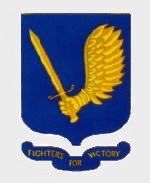Forces of Valor 80049 USAAF Bell P-39N-1 Airacobra Fighter - Edward S. Chickering, "Saga Boy II", 357th Fighter Group, United States, 1943 (1:32 Scale)
"Why should we have a navy at all? There are no enemies for it to fight except apparently the Army Air Force."
- General Carl Spaatz, Commander of the US 8th Army Air Force, after WWII
 The P-39 was one of America's first-line pursuit planes in December 1941. It made its initial flight in April 1939 at Wright Field and by the time of the Pearl Harbor attack, nearly 600 had been built. Its unique engine location behind the cockpit caused some pilot concern, but this proved to be no more of a hazard in a crash landing than with an engine located forward of the cockpit. However, the P-39's spin characteristics could be quite a problem if recovery techniques were ignored.
The P-39 was one of America's first-line pursuit planes in December 1941. It made its initial flight in April 1939 at Wright Field and by the time of the Pearl Harbor attack, nearly 600 had been built. Its unique engine location behind the cockpit caused some pilot concern, but this proved to be no more of a hazard in a crash landing than with an engine located forward of the cockpit. However, the P-39's spin characteristics could be quite a problem if recovery techniques were ignored.
The Airacobra saw combat throughout the world, particularly in the Southwest Pacific, Mediterranean and Russian theaters. Because its engine was not equipped with a supercharger, the P-39 performed best below 17,000 feet altitude, and it often was used at lower altitudes for such missions as ground strafing. When P-39 production ended in August 1944, Bell had built 9,584 Airacobras, of which 4,773 had been allotted to the Soviet Union. Russian pilots, in particular, liked the cannon-armed P-39 for its ground attack capability. Other P-39s served with French and British forces.
Pictured here is a 1:32 scale replica of a USAAF Bell P-39N-1 Airacobra fighter that was piloted by Edward S. Chickering, who was attached to the 357th Fighter Group during 1943.
Sold Out!
Dimensions:
Wingspan: 13-inches
Length: 11-1/2-inches
Release Date: December 2007
 Historical Account: "Tar-Paper Shacks" - The 357th remained at Hamilton Field, while its squadrons were activated and personnel and equipment acquired. Cadre for the new group were drawn from the 328th Fighter Group, already at Hamilton. Two of the three designated squadron commanders had served in the Philippines during the first days of the war, Major Hubert Egnes with the 17th Pursuit Squadron, and Captain Varian White with the 20th Pursuit Squadron, and both had air-to-air victories over Japanese aircraft.
Historical Account: "Tar-Paper Shacks" - The 357th remained at Hamilton Field, while its squadrons were activated and personnel and equipment acquired. Cadre for the new group were drawn from the 328th Fighter Group, already at Hamilton. Two of the three designated squadron commanders had served in the Philippines during the first days of the war, Major Hubert Egnes with the 17th Pursuit Squadron, and Captain Varian White with the 20th Pursuit Squadron, and both had air-to-air victories over Japanese aircraft.
On March 3rd, 1943, the group moved by rail to Tonopah, Nevada, where it remained until June 3rd. At Tonopah the members lived in and worked under primitive conditions, described as "tar-paper shacks", and without enclosed hangar maintenance facilities. They inherited much-used P-39 Airacobra fighters from the 354th Fighter Group, training at Tonopah preceding them, and immediately began a regimen of six-day work weeks with six sorties a day practicing air-to-air combat, bombing, and strafing maneuvers. While adequately powered at low altitudes and suited for close support operations, the P-39 was prone to stalls at higher altitudes. Three pilots and a flight surgeon died in training accidents while at Tonopah, including Captain White, who was replaced by Major Thomas Hayes, another veteran of the early Pacific campaign.
In June the group entered its next training phase, changing stations to Santa Rosa Army Air Field, California (the 362 Fighter Squadron was based at nearby Hayward). There the group continued training on P-39s, flying bomber escort and coastal patrol practice missions. On July 7th, 1943, a mid-air collision occurred between two P-39s, killing both pilots including Captain Clay Davis, commander of the 363 Fighter Squadron. On the same date the group commander, Lt.Col. Stetson, relinquished command, and sources who were present at the time are contradictory about a possible connection: Olmsted states that Stetson was sent overseas to command a fighter group; Yeager states he was relieved of command for the high death rate in training. Thirteen pilots and a flight surgeon died in P-39 training accidents in the United States, and numerous aircraft were lost or heavily damaged in non-fatal accidents.
The 357th received an influx of 60 new pilots and moved again, to bases at Oroville and Marysville, California in August 1943. It entered its final phase of training on September 28th with the squadrons redeploying to Second Air Force bases at Pocatello, Idaho; Casper, Wyoming; and Ainsworth, Nebraska, respectively, where they engaged in large-formation mock interceptor missions against bomber groups in training. On October 24th after a final tactical inspection, the group was declared ready for overseas deployment. Beginning November 3rd, the 357th turned in its P-39s and entrained for Camp Shanks, New York, where the entire group staged for embarkation aboard the RMS Queen Elizabeth, departing New York City on November 23rd, 1943. Debarking at Greenock, Scotland, on 29 November, the group immediately moved by train to its base in Suffolk.


